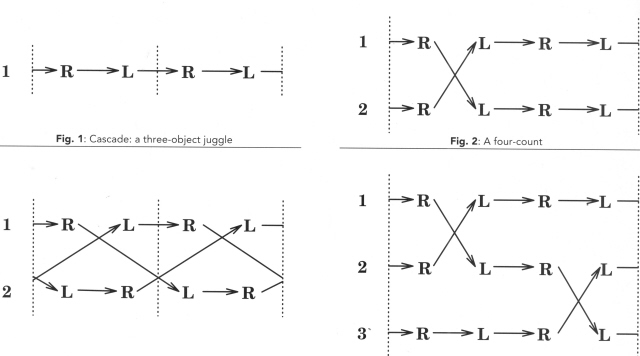 |
Page 44 Spring 1995
|
Causal
Diagrams I
wrote a computer program that implements one particular kind of
juggling notation known as causal diagramming (introduced to me by a
juggler named Martin Frost). This notation can be handy for doodling
around trying to find new multiperson passing patterns. (Actually, I
started writing the program. Its still rickety and unfinished, and
will probably always remain so - it was more an experiment in
QuickDraw GX programming than anything else.)
The
program implements a kind of active graph paper, allowing you to draw
only "legal" throws, and constraining your diagrams in
appropriate ways (such as preventing you from drawing throws that go
back in time, for a start).
Fig.
1 shows the diagram for a juggler doing a basic three-object pattern
(called a cascade), and will serve to show both how the notation works
and how juggling works. First the diagram: Time marches off inexorably
to the right, divided into nice, even steps (called counts} . A
juggler is represented through time as a row of Ls and Rs,
representing the jugglers left and right hands, alternately throwing
things. A thrown object is represented by an arrow from the hand that
throws it to the hand that catches it. The pattern wraps around at the
dotted lines, and repeats endlessly - or until someone drops
something. (The program always shows two repeating cycles like
this.) Note that the arrows (throws) form an unbroken line traveling
through time from left to right, and that each
Contrary
to what you might think at first glance, the overall path the arrows
make doesn't directly trace the path of an individual club. If it did,
this would just be a diagram of throwing one club back and forth
between two hands. (That's a necessary prerequisite to juggling, but
is definitely not juggling.) Instead, each throw displaces a club that
is always assumed to be held, waiting, in the receiving hand. Think of
the juggler as holding a club in each hand, while the third is in the
air. The incoming club displaces the club that's already there,
forcing the juggler to throw it elsewhere. In a cascade, the displaced
club is thrown back to the opposite hand, where it in turn displaces
the club that's there, which goes back to the first hand, displacing
the club that's there, and so on, ad infinitum. (Note that although
I'm saying "club" here, all these principles apply equally
well to balls or rings or rubber chickens.) So the chain of throws
is really a conceptual one, not a material one; it's a chain of cause
and effect through time. Diagrams
of Passing Fig.
2 shows two jugglers passing with each other (the repeated cycle was
cropped for space reasons). Note that they juggle in time with each
other, like musicians keeping a beat. (When juggling with clubs, you
actually hear the beat, when the clubs slap into the jugglers' hands.)
Both jugglers throw a club to each other at the same time, both from
the right hand (though it could just as well be the left). Throwing a
club to another juggler "breaks" the juggler's continuous
line of throws, but the
Because
of the close timing, both jugglers must agree on the pattern before
starting. The pattern in Fig. 2 is called a four-count because there's
a pass every four counts. (Another name for this pattern is every
other, referring to the fact that every other right hand throw is a
pass.) The four-count is a very common pattern, and for most club
jugglers this is the default, "idling" pattern. Since
there's so much time between passes, it's possible to do lots of fancy
free-form tricks (affectionately known as "throwing trash")
in the midst of the pattern. Of course, "so much time" isn't
really much time at all: a club juggle is roughly 160 counts per
minute, so there's just over a second between the passes in a
four-count.
These
diagrams show nothing about spatial relationships, by the way. The
usual situation has the jugglers facing each other 6 or 8 feet apart,
but the same patterns .can be done standing side by side, back to
back, or even with one juggler standing on the other's shoulders.
These diagrams show only the "connectedness" of the pattern
through time, and in fact you can draw patterns that work fine on
paper but are difficult to actually do because of mid-air collisions. |
 |